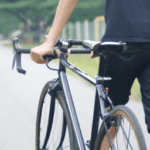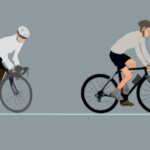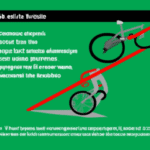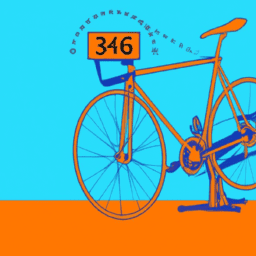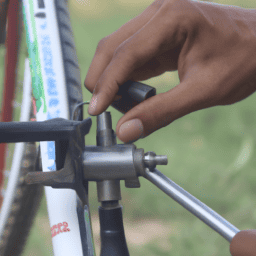Do you feel frustrated with your lack of smoothness and coordination every time you attempt to navigate a turn on your bicycle? Are you jealous of other riders who navigate corners with what seems like no effort at all? Worry no more, because with some practice and the right techniques, you can also excel at making those turns. Actually, you may even start to feel as if you’re floating above the ground as you lean into those bends.
Turning a bicycle may seem like a simple task, but there are actually several key components to executing a smooth and safe turn. From properly positioning your body to mastering advanced techniques, it takes a bit of know-how and practice to turn like a pro.
Whether you’re a seasoned cyclist or just starting out, this guide will provide you with all the tools you need to turn with confidence and finesse. So, let’s get started!
Key Takeaways
- Proper positioning and balance techniques are crucial for turning a bike.
- Feathering brakes and using both evenly can prevent skidding and maintain stability.
- Shifting weight towards the inside of the turn and leaning the bike in that direction helps with control and balance.
- Advanced techniques like dancing on pedals and jumping require practice and proper safety gear.
Properly Position Your Body
Make sure you’re leaning forward and gripping the handlebars tightly as you prepare to turn your bike. This position will give you better control over the bike and help you maintain balance throughout the turn. To achieve this, start by shifting your weight forward and keeping your elbows bent. This will allow you to easily maneuver the bike as you turn.
Balance techniques are also important when it comes to turning your bike. Your riding posture plays a crucial role in maintaining balance. Keep your knees slightly bent and your weight evenly distributed on both pedals. This will help you stay centered on the bike and keep your balance as you turn.
By properly positioning your body and using these balance techniques, you’ll be able to turn your bike smoothly and with ease.
Now, to use your brakes, you’ll want to…
Use Your Brakes
When using your brakes on a bicycle, it’s important to remember a few key points.
First, feather your brakes by lightly applying pressure to slow down gradually.
Second, use both brakes evenly to prevent skidding or loss of control.
Finally, release the brakes slowly to prevent jerky movements and maintain stability.
By following these guidelines, you can effectively and safely use your brakes while cycling.
Feather Your Brakes
If you want to turn smoothly, ease up on your brakes like a graceful bird spreading its wings. Feathering your brakes means applying light pressure on them to slow down gradually. Doing so will allow you to maintain control of your bike as you make the turn.
To feather your brakes, follow these steps:
-
Adjust brake tension: Ensure that your brakes aren’t too tight or too loose. You can do this by adjusting the tension on the brake cables. A tight brake can cause your wheels to lock up, making it difficult to turn. On the other hand, a loose brake won’t provide enough stopping power when you need it.
-
Types of brake pads: There are two types of brake pads – rubber and metal. Rubber pads are softer and provide better grip, while metal pads are harder and last longer. Choose the type of brake pad that suits your needs and replace them when necessary.
Feathering your brakes is an essential technique when turning your bike. It helps you maintain control and avoid accidents. Once you’ve mastered this skill, you can move on to the next step using both brakes evenly.
Use Both Brakes Evenly
Now it’s time to master using both brakes evenly, smoothly slowing down to maintain control and avoid skidding. Brake balance is essential in turning your bicycle. As you approach a turn, apply both brakes evenly to slow down to a turning speed that allows you to make the turn safely.
Using too much front brake can cause you to lose control and go over the handlebars. On the other hand, using too much rear brake can cause your back wheel to skid, leading to an uncontrolled skid. By using both brakes evenly, you’ll maintain control and slow down smoothly while turning. Remember to release the brakes slowly as you exit the turn to regain your speed and momentum.
Now that you’ve mastered brake balance and using both brakes evenly, it’s time to learn how to release the brakes slowly to maintain control and avoid skidding.
Release the Brakes Slowly
As you release the brakes slowly, you’ll be able to maintain control and avoid skidding. Gradually releasing the brakes for smooth turns and avoiding sudden jerks is crucial for maintaining balance and control when turning on a bicycle.
When you suddenly release your brakes, the weight of your body shifts forward, causing the front wheel to lift off the ground, which can lead to a loss of control and a potential accident.
In addition to gradual brake release, body posture plays a significant role in efficient braking and turning on a bicycle. As you approach a turn, shift your weight towards the inside of the turn. This will help you maintain balance and control, and also enable you to take sharp turns with ease.
With the combination of gradual brake release and proper body posture, you can make turns smoothly and safely.
Shift Your Weight
When you want to turn your bicycle, simply shift your weight in the direction you want to go. This is one of the most basic and fundamental techniques for turning a bike. However, this technique requires some practice to master.
Here are some tips to help you get started:
-
Lean control: As you shift your weight, make sure to lean your bike in the direction you want to turn. This will help you maintain control and balance throughout the turn.
-
Counterbalance techniques: As you lean your bike, try to counterbalance your weight by leaning your upper body in the opposite direction. This will help you maintain stability and control, especially when making sharp turns.
By mastering these techniques, you’ll be able to turn your bike smoothly and efficiently, even at high speeds. However, it’s important to practice in a safe environment before attempting more complex maneuvers.
In the next section, we’ll discuss some important safety tips to keep in mind while practicing.
Practice in a Safe Environment
It’s crucial to prioritize safety when practicing your maneuvering skills on your bike. One way to ensure a safe environment is to find a mentor who can guide you through the process. This person should be experienced and knowledgeable about bike handling techniques. They can provide feedback on your performance and help you identify areas for improvement. Additionally, having a mentor can give you the confidence to push yourself further without putting yourself in danger.
Another way to practice in a safe environment is to utilize obstacles. Setting up cones or other objects can help you develop your turning skills without risking injury. Start with simple exercises, such as weaving in and out of cones, and gradually progress to more complex maneuvers. Remember to always wear proper safety gear, including a helmet and pads, and avoid practicing in areas with heavy traffic or other hazards.
By taking these precautions, you can master basic turning techniques and prepare yourself for more advanced maneuvers.
As you become more comfortable with turning your bike, it’s time to master advanced techniques.
Master Advanced Techniques
Once you’ve honed your skills in a safe environment, you can start exploring the thrilling world of advanced bike maneuvers. These moves require a high level of balance control and steering techniques. It’s important to note that mastering these skills takes time and practice, so be patient and don’t get discouraged if it takes a few tries to get it right.
One advanced technique is called ‘dancing on pedals,’ which involves shifting your weight back and forth on the bike while pedaling. This move is great for navigating tight turns and technical terrain.
Another technique is ‘soaring through the air like a bird,’ also known as jumping. This move requires precise timing and speed control, as well as the ability to stay balanced in the air. Keep in mind that jumping can be dangerous, so make sure you have the proper safety equipment and start with small jumps before attempting larger ones.
Frequently Asked Questions
What is the best type of bicycle to turn?
If you’re interested in mastering tight turns, you’re likely wondering which type of bike is better for the job. Mountain bikes tend to perform better due to their wider tires and lower center of gravity. However, with the right technique, any bike can handle tight turns. Tips for mastering tight turns on any type of bike include: looking where you want to go, leaning into the turn, and shifting your weight to the outside pedal.
How do I know if I’m turning too sharply?
If you feel like you’re leaning too much or your handlebars are turning too much, you might be turning too sharply. Common mistakes include not looking ahead and not properly shifting your weight. Proper body positioning can help prevent these mistakes.
Can I turn at high speeds?
Can you turn at high speeds on a bicycle? Yes, with proper handling techniques and body positioning. Keep your weight centered and lean into the turn, while using your handlebars to guide your direction. Practice on flat terrain before attempting on hills.
How can I prevent my bike from skidding while turning?
Prevent skidding while turning by using the countersteering technique, which involves pushing the handlebar in the opposite direction of your desired turn. Ensure proper tire pressure to maintain traction and control.
Is it necessary to use hand signals while turning?
Hand signals are essential for safe cycling. They communicate your intentions to other road users and prevent accidents. Legal requirements for hand signals while turning vary by state, but it’s always a good idea to use them.
Conclusion
Congratulations! You’re now a master of the art of turning a bicycle. With proper body positioning, brake usage, weight shifting, and practice in a safe environment, you can now turn with precision and finesse.
But wait, there’s more! Now that you’ve mastered the basics, it’s time to take it up a notch. Advanced techniques such as countersteering, leaning, and carving can elevate your turning game to a whole new level.
With these techniques, you can turn on a dime and navigate even the tightest corners like a pro. So go forth and conquer the roads, with your newfound skills and confidence on the bike.
Happy cycling!



